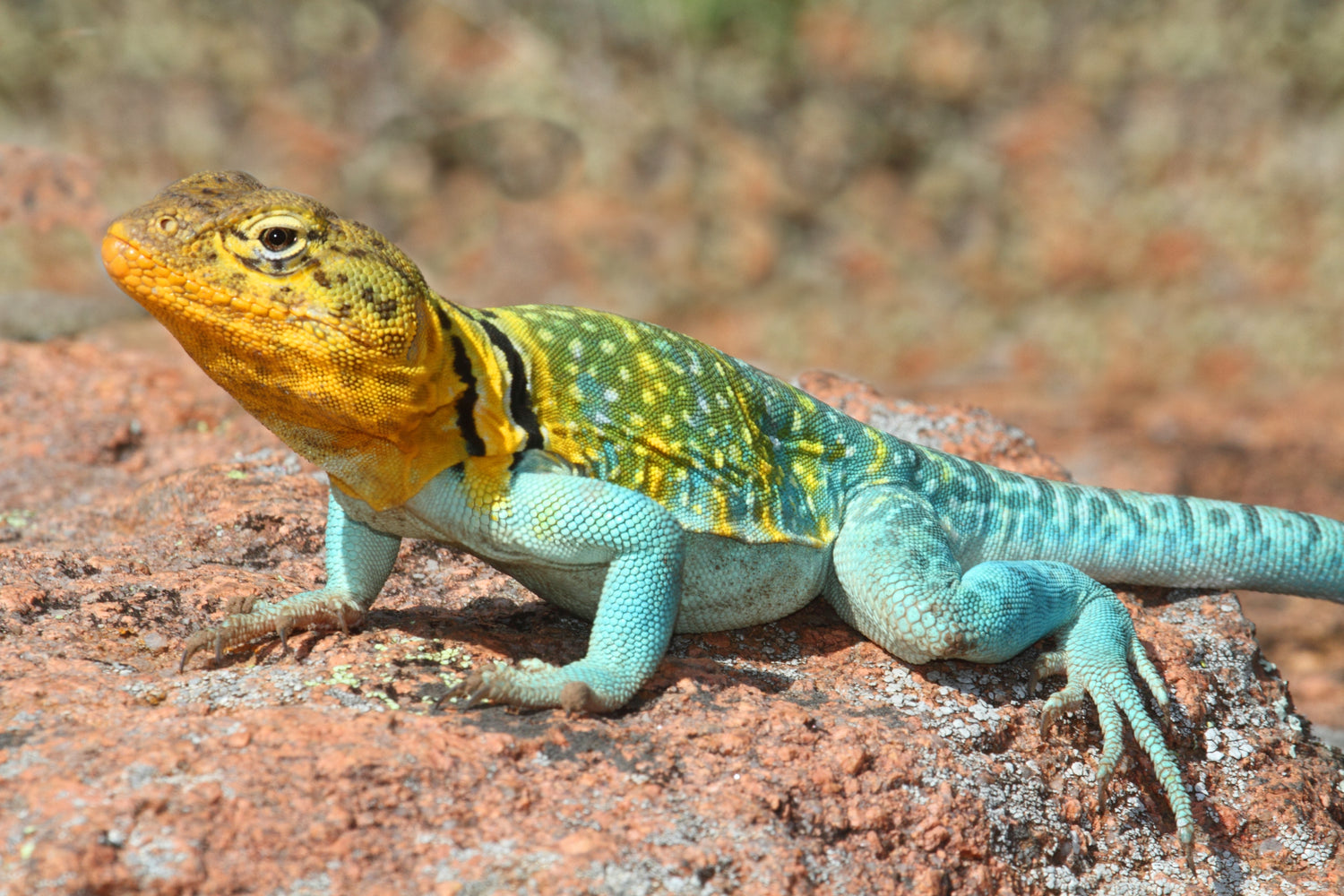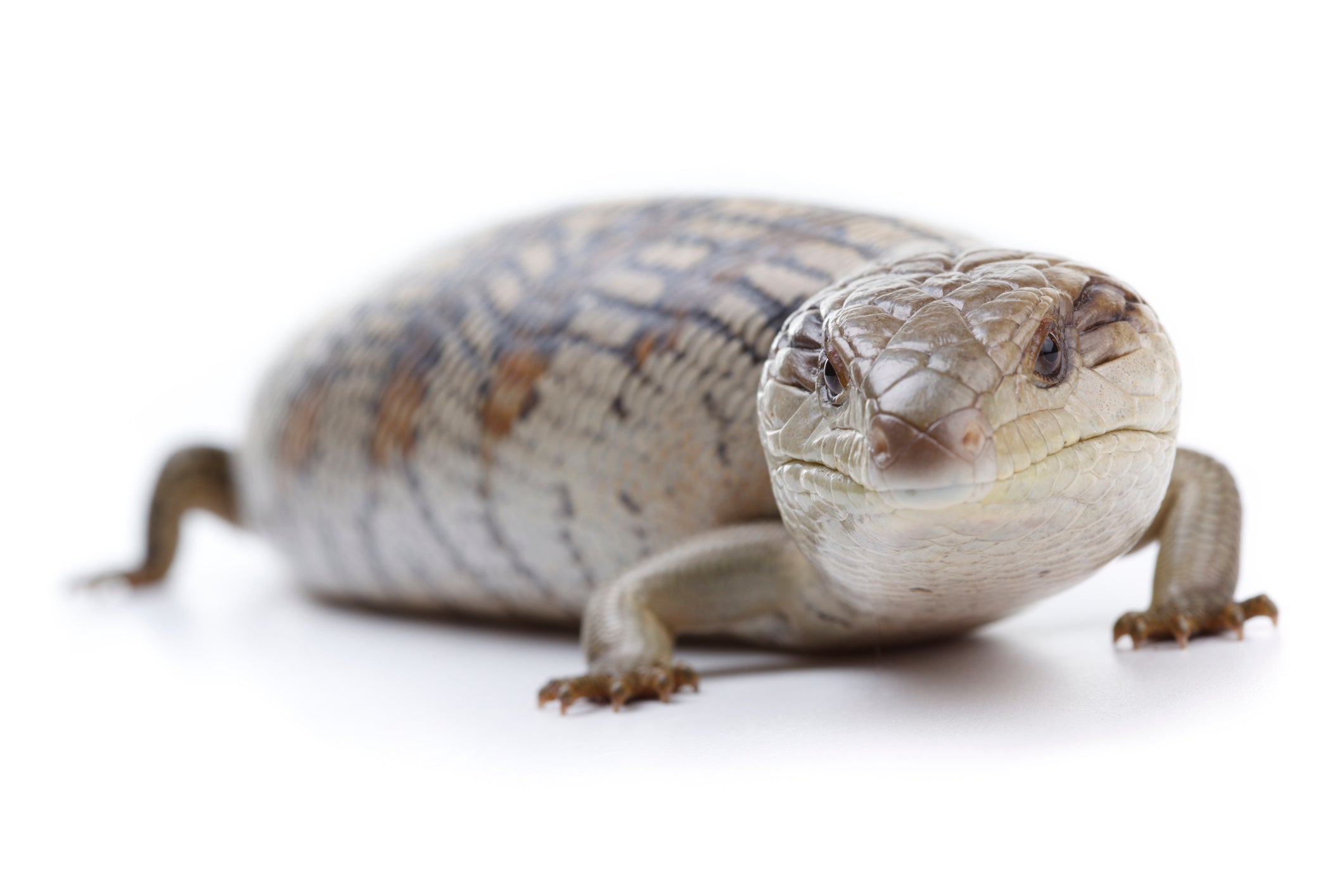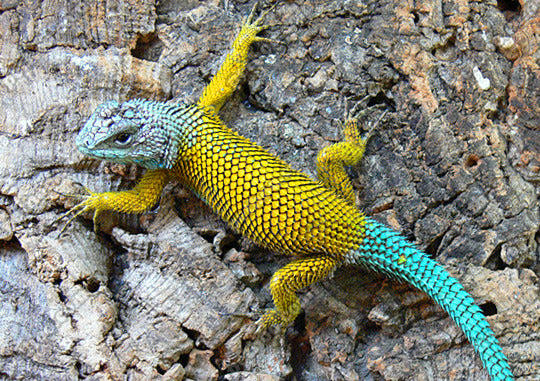Collared lizards (Crotaphytus spp.) are small to medium-sized diurnal, terrestrial lizards that can be found in the southwestern US and northern Mexico, including the Baja peninsula. They can be found in desert scrub/chapparal and dry grassland habitats with rocky terrain. Adults average 8-12” long, depending on species, although there are reports of some as long as 14”. Collared lizards generally live 5-8 years in captivity, although longer is possible with good care.
Collared lizards’ build is generally slim and athletic, with a large, blunt head, a somewhat rounded midsection, relatively long legs, and a long, slender tail. Aside from a spotted pattern and the telltale “collar” markings around the neck, coloration can vary widely from species to species.
There are 9 species of collared lizard:
Collared lizards are uncommon in the US pet trade, but they can make good display animals for someone looking for a small pet lizard. They are not the best pet for someone looking for a lizard that will tolerate frequent handling.
Collared lizards’ care requirements are generally fairly similar from species to species, however there are essential differences that should be noted. This care sheet should be used only as a general guide, and we strongly recommend doing research on your specific species/subspecies of collared lizard for best results.
How much space do collared lizards need?
A single collared lizard should be housed in no smaller than a 36” x 18” x 18” enclosure (~40 gallons). However, collared lizards are very active lizards, so if you can provide a larger enclosure, do it!
Cohabitation is optional. They don't need to be housed with other collared lizards, but it can be done successfully. If you wish to keep multiple collared lizards in the same terrarium, do not house multiple males together, as they are territorial and will fight. Small groups of similarly-sized females seem to be the safest option. A male and female(s) should only be kept together if you wish to breed. For housing multiple collared lizards in one enclosure, you will need a 48” x 24” x 24” or larger.
Do collared lizards need UVB?
Yes! Collared lizards are diurnal, which means that they are most active during the day, and naturally exposed to lots of sunlight on a day-to-day basis. This means that they need UVB light as part of their enclosure. The best UVB bulbs for a collared lizard housed in a 36-48” long enclosure are:
If the UVB is mounted over mesh, place the basking area 4-6” below the lamp. If the UVB is mounted inside the enclosure, place the basking area 6-8” below the lamp. The basking area should be the closest surface to the UVB bulb. The UVB bulb should be housed in a reflective fixture and placed on the basking side along with the heat lamp. Also note that UVB is blocked by glass and plastic, so you can’t give your lizard UVB by placing its terrarium in front of an open window. Also make sure that the fixture your UVB bulb is in does not have a clear plastic bulb cover.
In addition to UVB, since collared lizards are day-active lizards, it’s beneficial to provide an additional daylight-spectrum lamp to make sure the enclosure is brightly illuminated. Use a strong 6500K LED or T5 HO fluorescent plant grow light for best results.
Collared lizards should get 10 hours of light per day during winter and 14 hours of light per day during summer. This simulates natural seasonal changes in day length and encourages healthier hormonal rhythms.
What basking temperatures do collared lizards need?
Collared lizards like it hot! They should have a basking surface temperature between 105-120°F, with a cool side temperatures between 75-90°F. Nighttime temperatures should be between 68-78°F, which can usually be accomplished by turning off the heat source. Measure your temperatures with a digital probe thermometer with the probe placed on the desired surface.
Provide heat for your collared lizard by imitating the sun with a halogen heat lamp placed on one side of the enclosure. Do not use ceramic heat emitters (CHEs), heat mats, red bulbs, or blue bulbs, as these are not as effective. For best results, the basking surface itself should be a large, flat piece of rock.
What humidity levels do collared lizards need?
It depends on the species. Collared lizards from the western part of their distribution do well between 30-40% humidity, while eastern collared lizard species are more likely to prefer humidity between 50-60%. Measure average humidity levels in your terrarium with a digital probe hygrometer, with the probe in the middle of the enclosure.
As long as they have a humid hideout or burrow, though, humidity isn’t something to worry about too much with these lizards. However, occasional misting with a spray bottle or pressure sprayer is a good way to help keep humidity within a healthy range.
What substrate is good for collared lizards?
Substrate covers the floor of your lizard’s terrarium and helps make the enclosure more attractive, but it also helps maintain desired humidity levels and provides something for your collared lizard to dig around in.
It’s ideal to use a substrate that imitates the “substrate” that the reptile naturally lives on in the wild. For collared lizards, that means sand or sandy soil. We recommend the following substrates for collared lizards:
- Zoo Med ReptiSand
- Exo Terra Desert Sand
- Play sand
Substrate should be at least 4” deep and completely replaced every 3-4 months. Remove poop and urates daily, along with contaminated substrate.
What decor can you use in a collared lizard terrarium?
Collared lizards get bored easily. Using a large enough enclosure is the first step toward preventing this, but it’s also important to provide enrichment to help keep them busy and entertained. It doesn’t matter how big the enclosure is if you don’t put things in it for your pet to use and interact with.
At bare minimum, you will need at least one “cave” for the collared lizard to hide in and a flat stone for basking on. However, it’s best to include other items, such as:
- secure stacks of flagstone or aquarium slate
- more hiding places
- ledges
- hollow logs
- branches
- live or artificial plants
- dry shrubs
What do collared lizards eat?
Collared lizards are primarily insectivorous, which means that they need to eat insects (preferably live) in order to get the nutrition that their bodies need. Offer food every morning, as much as they can eat in one day. Juveniles will generally eat more than adults do.
Variety is the key to balanced nutrition, so make sure to offer as many different kinds of bugs as possible!
Feeder insects for collared lizards: dubia roaches, discoid roaches, red runner roaches, crickets, black soldier fly larvae, hornworms, mealworms
Supplements
You will also need calcium and vitamin supplements to prevent your lizard from developing a deficiency. We recommend Repashy Calcium Plus LoD, lightly dusted on all of your lizard’s feeder insects.
Water
Although collared lizards are perceived as desert reptiles, they still need access to fresh water. Provide a small water bowl where your lizard can always get a drink when needed. Change the water daily and scrub the bowl with a reptile-safe disinfectant weekly, or whenever it becomes soiled.
Do collared lizards like to be handled?
Few reptiles actually “like” to be held, and although collared lizards can learn to tolerate it, they’re not really a pet that you can hold often. Instead of interacting with your lizard by holding it, try hand-feeding it instead with a pair of feeding tweezers.
*This care sheet contains only very basic information. Although it’s a good introduction, please do further research with high-quality sources to obtain additional information on caring for this species.




Leave a comment
This site is protected by hCaptcha and the hCaptcha Privacy Policy and Terms of Service apply.